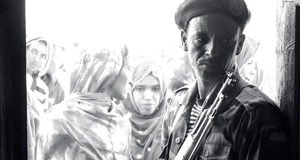Featured Article:Imagining Ethiopia: The Contrasting Views of Ethiopian Power, Progress, and Significance
By
2017, Vol. 9 No. 02 | pg. 2/2 | « Emperor Haile Selassie himself was consistently tied to the African decolonization movement, as the spokesman for all of Africa at a global scale. As he earned international admiration for Ethiopia, he reflected positively upon Africa. In 1963, Selassie met with 29 other heads of state in Addis Ababa, the largest meeting of African heads of states ever assembled and was voted the honorary President of the conference. Selassie was firmly aware of the need for economic and political unity among Africans and the required sense of urgency needed during the period. Selassie was able to command the attention of the world as he traveled broadly and arouse the morality of the world when necessary during periods of political and human rights injustices. The most apparent failure of the Ethiopian state gives some validity to the argument of Ethiopia as a weak and divided entity. The disintegration of the nation post-Haile Selassie era shows the failure of the Emperor Tewodros experiment begun in 1888 to bring a centralized and multi-ethnic state. Although Emperor Selassie did modernize the nation to a considerable extent, significant valid charges of the Ethiopian peasantry did exist. These included extreme poverty, torture by the Ethiopian military, widespread hunger, illiteracy, failure of infrastructure development including healthcare services and corruption within the imperial court. To illustrate the poor prioritization of resources which many consider an injustice, in a country of 30 million farmers, agriculture received one percent of the national budget and the police and army – the largest in Africa, received 40 percent (Meyers 52). An older Emperor Selassie was seen by a large portion of Ethiopians as out of touch with reality and a demagogue unable to mask the corruption present in the nation. The following revolution would lead to the rise of Colonel Mengistu Haile Mariam in 1977 eventually creating an authoritarian socialist state emerging from a violent period of state-sanctioned genocide known as the ‘Red Terror.’ Mass killings spread across the countryside, opposition groups were targeted and tortured especially the left-wing Ethiopian Peoples’ Revolutionary Party (EPRP) and the educated class were decimated. Between an estimated 30,000 to 500,000 people were killed during the Red Terror’s peak between 1974 and 1978, although many of the killings would continue into the 1990s. The shift from absolutism to democracy contained a socialist intermediate.Colonel Mengistu instituted Marxist-Leninist doctrine and received over $3 billion in aid from Moscow, while serious social and economic issues lingered including the exposure of over 4.5 million Ethiopians to famine (Greenwald). The economy became a state-operated centralized entity welcoming foreign investment. Hundreds of thousands of Ethiopians were resettled in controversial villagization programs similar to Stalin’s collectivization policies of the 1930s. Three million peasants were relocated at a cost of considerable deaths, families being broken apart and thousands of refugees fleeing to Somalia, Kenya and Sudan. Interestingly, Colonel Mengistu would realize the plight of Ethiopia’s situation and exploit the differences between Cold War power blocs and not fully commit to either. Ethiopia was seen as the key to the strategic Horn of Africa including the Nile and the Red Sea, Mengistu was able to cleverly utilize his geopolitical influence to receive over $280 million in emergency aid from Washington and received billions in military aid from Moscow. Without fully committing to either, Ethiopia was able to toe the thin line between the West and East and receive the benefits of both alignments. The dissatisfaction of the state of the nation would fuel a novel experiment in the 1990s known as Ethnic Federalism. Plagued with ethnic problems for centuries, until 1991 the policies of numerous regimes were to suppress the unique cultural identities of over 80 distinct ethno-linguistic groups and assimilate them into the dominant Amhara culture. This would resolve in lingering tension and claims of historic discrimination and inequality (Keller 21). The new incoming coalition: the Ethiopian People’s Revolutionary Democratic Front (EPRDF) was an umbrella organization of numerous ethnically based opposition groups advocating the full expression of their cultures through separate regional governments in the name of social equality and democracy. The creation of the Federal Democratic Republic of Ethiopia can be seen as a form of national self-determination expressed by Woodrow Wilson and the League of Nations post World War I applied on an intra-national scale. Their claims illustrate the failure of imperial integration through the Emperor Tewodros experiment begun in 1888 to create a multi-ethnic and unified Ethiopian state. The ‘national question’ would also remain unresolved and plague Emperor Selassie; scholars claim the emperor had cultivated a myth domestically and abroad of the unification of Ethiopia (28). However, unresolved ethnic and regional animosity would re-emerge after his regime. Although the intent of the EPRDF has been commended internationally, flaws remain in the federalist system including the inconspicuous dependency of the nine ethic states upon the national unit due to fiscal imbalances. Rather than building consensus, ethnic power blocs and the resulting discrimination of minority groups within certain states have emerged through devolution. Furthermore, a hyper-centralized form of federalism has been imposed not upon request from the nation’s citizens but from atop – the EPRDF government has been able to systematically neutralize political opposition and place political elites atop the regional governments (32). Ethnic Federalism has instead indirectly increased the power of the central government and lead to widespread controversy and conflict that continues today. This can be viewed by outsiders as a form of backwardness that has plagued Ethiopia. However, to rebut this viewpoint it can be understood that this transition is incomplete and expresses a distinctly Ethiopian pursuit of controlling their own independent destiny. The sense of continuing progress and desire for true and not superficial national self-determination to settle their ethnic disputes through a willingness to boldly undergo broad organizational reform. This social movement is not seen by the West and is another example of broad unrecognition of the true and current state of the Ethiopian union. Ethiopia’s complex history lends itself to a contentious present. Although Ethiopia is not emblematic of the ‘Dark’ Continent myth due to its considerable international influence, systemic flaws still remained hidden within. The presence of Haile Selassie and forthcoming movements had a global impact, inspiring millions across the West and members of over 60 new African nations seeking a path to follow. The Ethiopian Exception, for its profound strength and weakness possesses an interesting enigma in the study of revolutions. Distinctly independent and fiercely sovereign, understanding this mysterious land and their sense of self reveals the spirit of a people and also diasporas and colonial revolutionaries: their values, desires and future goals. Doing so paves the way to a more complete understanding of diplomacy, race relations and complex international collaborations between eclectic cultures to form the harmonious Making of the Modern World we hope to see today. ReferencesAllain, Jean. "Slavery And The League Of Nations: Ethiopia As A Civilised Nation." Journal Of The History Of International Law 8.2 (2006): 213-244. Academic Search Complete. Web. 29 May 2016. Bassil, Noah R. "The Roots Of Afropessimism: The British Invention Of The ‘Dark Continent’." Critical Arts: A South-North Journal Of Cultural & Media Studies 25.3 (2011): 377-396. Academic Search Complete. Web. 28 May 2016. Chamley, Santorri. "The Rise and Rise of Black Consciousness." New African 470 (2008): 80-84. Academic Search Complete. Web. 17 May 2016. Commey, Pusch. "The Battle of Adwa: When Ethiopia Crushed Italy!" New African 48.539 (2014): 30-31. Academic Search Complete. Web. 18 May 2016. Clapham, Christopher. "How Many Ethiopias?" Africa (Edinburgh University Press) 63.1 (1993): 118-128. Academic Search Complete. Web. 15 May 2016. Darkwah, Kofi. Aspects of the 19th Century History of Ethiopia. Institute of African Studies, University of Ghana, 1970. "ETHIOPIA A FORGOTTEN WAR RAGES ON Once More, Eritrean Rebels Fight Off a Government Offensive."Time126.25 (1985): 36. Academic Search Complete. Web. 13 Apr. 2016. Greenwald, John, and James Wilde. "ETHIOPIA RED STAR OVER THE HORN OF AFRICA an Impoverished Land Tilts to The East But2 Seeks Western Help." Time 128.5 (1986): 32. Academic Search Complete. Web. 17 May 2016. Keller, Edmond J. "Ethnic Federalism, Fiscal Reform, Development and Democracy in Ethiopia." MacCreagh, Gordon. “King of Kings.” The Saturday Evening Post [Indianapolis] 21 Sep. 1935: 8-9, 86-90. Print. Meyers, Jeffrey. "Abyssinia Out of the Shadows." History Today 65.11 (2015): 49-54. Academic Search Complete. Web. 15 May 2016. Tegegn, Melakou. "Mengistu's ‘Red Terror’." African Identities 10.3 (2012): 249-263. Academic Search Complete. Web. 22 May 2016. Suggested Reading from Inquiries Journal
Inquiries Journal provides undergraduate and graduate students around the world a platform for the wide dissemination of academic work over a range of core disciplines. Representing the work of students from hundreds of institutions around the globe, Inquiries Journal's large database of academic articles is completely free. Learn more | Blog | Submit Latest in History |


















